Attached files
| file | filename |
|---|---|
| 8-K - 8-K - Fibrocell Science, Inc. | fcsc21218form8-k.htm |

Corporate Presentation
February 12, 2018
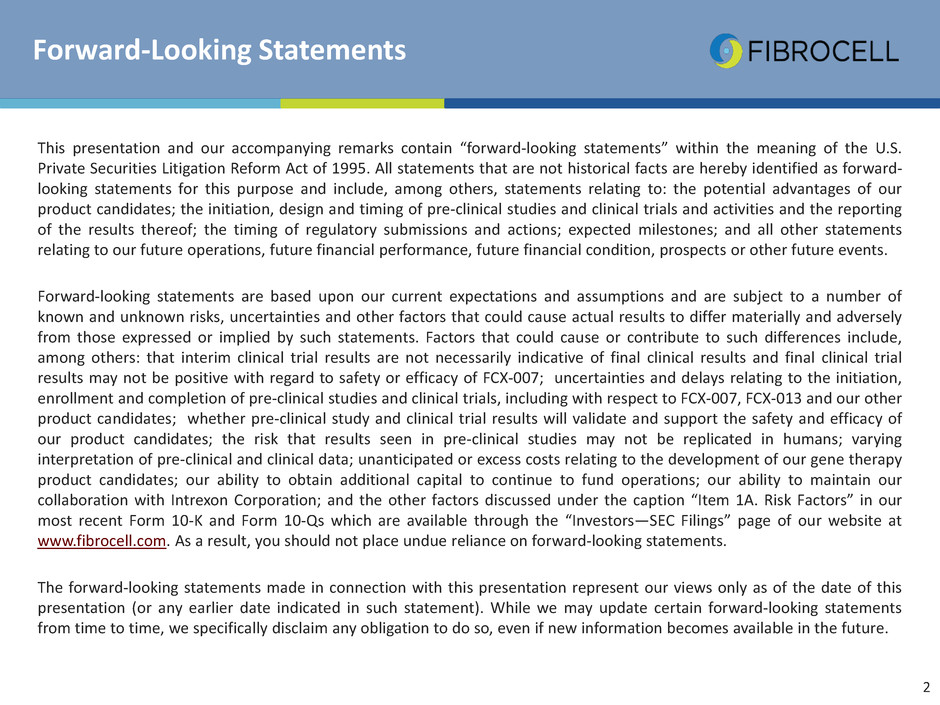
Forward-Looking Statements
This presentation and our accompanying remarks contain “forward-looking statements” within the meaning of the U.S.
Private Securities Litigation Reform Act of 1995. All statements that are not historical facts are hereby identified as forward-
looking statements for this purpose and include, among others, statements relating to: the potential advantages of our
product candidates; the initiation, design and timing of pre-clinical studies and clinical trials and activities and the reporting
of the results thereof; the timing of regulatory submissions and actions; expected milestones; and all other statements
relating to our future operations, future financial performance, future financial condition, prospects or other future events.
Forward-looking statements are based upon our current expectations and assumptions and are subject to a number of
known and unknown risks, uncertainties and other factors that could cause actual results to differ materially and adversely
from those expressed or implied by such statements. Factors that could cause or contribute to such differences include,
among others: that interim clinical trial results are not necessarily indicative of final clinical results and final clinical trial
results may not be positive with regard to safety or efficacy of FCX-007; uncertainties and delays relating to the initiation,
enrollment and completion of pre-clinical studies and clinical trials, including with respect to FCX-007, FCX-013 and our other
product candidates; whether pre-clinical study and clinical trial results will validate and support the safety and efficacy of
our product candidates; the risk that results seen in pre-clinical studies may not be replicated in humans; varying
interpretation of pre-clinical and clinical data; unanticipated or excess costs relating to the development of our gene therapy
product candidates; our ability to obtain additional capital to continue to fund operations; our ability to maintain our
collaboration with Intrexon Corporation; and the other factors discussed under the caption “Item 1A. Risk Factors” in our
most recent Form 10-K and Form 10-Qs which are available through the “Investors—SEC Filings” page of our website at
www.fibrocell.com. As a result, you should not place undue reliance on forward-looking statements.
The forward-looking statements made in connection with this presentation represent our views only as of the date of this
presentation (or any earlier date indicated in such statement). While we may update certain forward-looking statements
from time to time, we specifically disclaim any obligation to do so, even if new information becomes available in the future.
2

Proprietary
autologous fibroblast
cell capabilities
+
Ex vivo genetic
modification of
patients’ own
fibroblast cells
FCX-007
Recessive Dystrophic
Epidermolysis Bullosa
(RDEB)
FCX-013
Moderate to Severe
Localized Scleroderma
Arthritis and related
conditions
3
Fibrocell at a Glance
Personalized medical breakthroughs for
diseases of the skin and connective tissue
• Interim data from three patients reported in Phase 1
• First adult patient enrolled in Phase 2
• Obtained FDA allowance to initiate enrollment of pediatric
patients in Phase 2
Orphan Drug Designation
Rare Pediatric Disease Designation
Fast Track Designation
• Submitted IND to FDA
• Completed GLP biodistribution/toxicology study
• Safety clinical trial expected to initiate in 2018
Orphan Drug Designation
Rare Pediatric Disease Designation
• Deliver therapeutic protein locally to the joint providing
sustained efficacy while avoiding key side effects typically
associated with systemic therapy
Portfolio being developed in collaboration with

Autologous fibroblasts
harvested from patients
• Readily sourced, as
fibroblasts are the most
common cell type in skin
and connective tissue
• Reduced rejection and
immunogenicity concerns
because the donor is the
patient
• Established manufacturing
process and regulatory
pathway for autologous
fibroblasts
Lentiviral vector gene
transfer
• 3rd generation and self-
inactivating for additional
safety
• Accommodates large gene
constructs
• Transduces both dividing
and non-dividing cells
• Target gene integration for
long-term expression of the
protein
Ex vivo gene
modified cells
• Confirmation vector
copy number and
protein expression
levels prior to dosing
• Live virus is not
administered directly
into patients
4
Our Autologous Fibroblast Gene Therapy Platform
Delivery Vehicle Vector
Ex vivo
Modification
FCX-007 autologous dermal fibroblasts in culture

Personalized Biologics Approach
5

Development Pipeline
6
Program Condition Target Research
Pre-Clinical
Development
Human Clinical
Trials
FCX-007 Recessive Dystrophic
Epidermolysis Bullosa
(RDEB)
Type VII Collagen
FCX-013 Moderate to Severe
Localized Scleroderma
MMP-1
Research Arthritis and Related
Conditions
TBD

FCX-007 Providing Hope for RDEB Patients
7
RDEB patients do not produce type VII
collagen (COL7) due to mutation in COL7A1
gene
• Main component of anchoring fibrils that
connect skin layers
FCX-007 is an autologous human dermal
fibroblast transduced with a lentiviral (LV)
vector encoded for COL7A1
• Local injection to the papillary dermis
Photo credit: Science Photo Library

About RDEB
8
Disease Current Treatments Epidemiology
• Cause: A mutation in the
COL7A1 gene that encodes
for COL7
• Devastating, progressive,
painful blistering disease
that often leads to death
• Diagnosed at infancy
• High mortality rate – 76% of
RDEB patients do not live
past their 30’s1
• Current treatments only
address symptoms
Bandaging & antibiotics –
bandaging alone can
exceed $10,000 per
month2
Feeding tubes
Surgery, including hand
and esophageal
Dystrophic EB (DEB)
~5,500 – 12,500 US3
• RDEB
~1,100 – 2,500 US4

Functional COL7 Expression Confirmation
9
Culture supernatant evaluated for in vitro COL7 expression
• ELISA assay indicates virus dose-dependent protein expression
• Trimeric form of COL7 produced by RDEB patient fibroblasts
transduced with LV-COL7
•Must be trimeric to be functional
Reference: Bruckner-Tuderman, Leena. Can Type VII Collagen Injections Cure Dystrophic
Epidermolysis Bullosa? Molecular Therapy (2008) 17 1, 6–7.
COL7 Formation
Trimeric Form
(900kDa)
RD
EB
+
C
o
n
tr
o
l
P
u
ri
fi
ed
C
OL
7
FC
X
-0
0
7
-0
1
FC
X
-0
0
7
-0
2
COL7 IP
Immunoprecipitation (IP)/Western Blot
Trimeric COL7
(900kDa)
In vitro studies show FCX-007 results in
expression of COL7 in functional trimeric form

RDEB Patient’s
Non-Transduced Fibroblasts
• RDEB patients lack COL7A1 gene that plays
critical role forming anchoring fibrils &
providing integral stability to skin
• In vitro studies show production of functional
trimeric structure COL7 which RDEB patients
lack capability to produce
• In vivo studies show COL7 expression detected
at basement membrane zone and underlying
dermis just 17 days after injection
Xenografts on immunodeficient mice
RDEB Patient’s Fibroblasts
Transduced with FCX-007
Normal Human
Fibroblasts
FCX-007 is a personalized therapeutic approach
addressing the underlying cause of RDEB No COL7
production
After FCX-007
transduction
COL7 (in green)
production
begins in same
RDEB patient
fibroblasts
Treating Underlying Pathology of RDEB
10
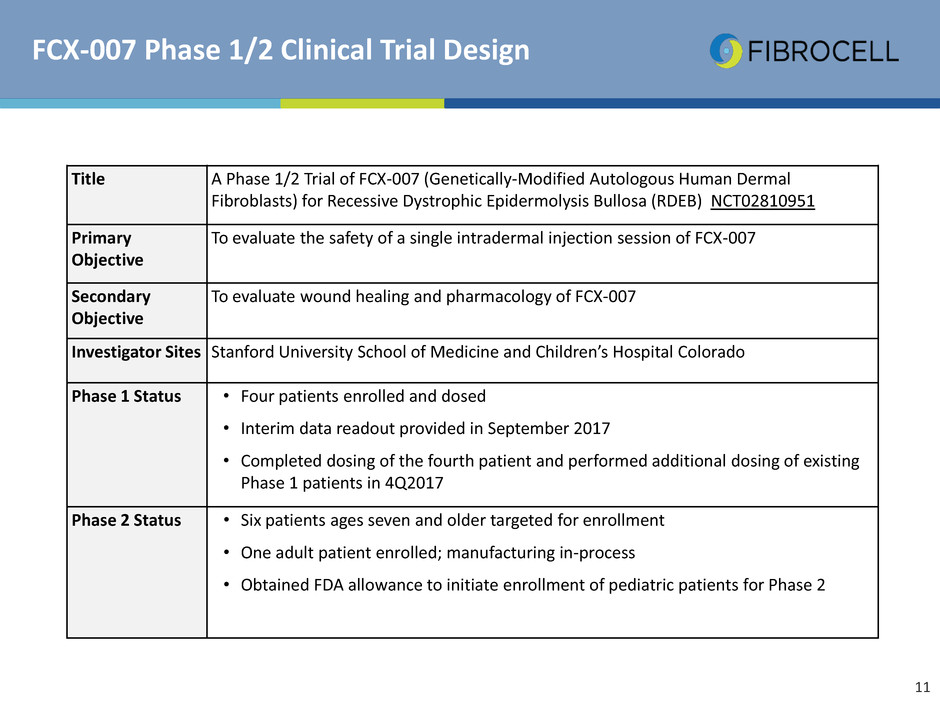
FCX-007 Phase 1/2 Clinical Trial Design
11
Title A Phase 1/2 Trial of FCX-007 (Genetically-Modified Autologous Human Dermal
Fibroblasts) for Recessive Dystrophic Epidermolysis Bullosa (RDEB) NCT02810951
Primary
Objective
To evaluate the safety of a single intradermal injection session of FCX-007
Secondary
Objective
To evaluate wound healing and pharmacology of FCX-007
Investigator Sites Stanford University School of Medicine and Children’s Hospital Colorado
Phase 1 Status • Four patients enrolled and dosed
• Interim data readout provided in September 2017
• Completed dosing of the fourth patient and performed additional dosing of existing
Phase 1 patients in 4Q2017
Phase 2 Status • Six patients ages seven and older targeted for enrollment
• One adult patient enrolled; manufacturing in-process
• Obtained FDA allowance to initiate enrollment of pediatric patients for Phase 2

FCX-007 Interim Data Readout
• Interim readout of data for three NC1+ adult Phase 1 patients, 12 weeks post-
administration
• Single injection session of FCX-007 to target wounds or preliminary safety assessment
• Five wounds treated over three patients ranging from 4.4cm2 to 13.1cm2 in size
• FCX-007 was well tolerated through 12 weeks post-administration
No serious adverse events or product related adverse events
No replication competent lentivirus (RCL) detected
Low to no autoantibody response detected
• Positive early trends noted in pharmacology signals and wound healing
• The Data Safety Monitoring Board (DSMB) concluded that safety and potential benefit
were established, and allowed continuation of enrollment and dosing
12
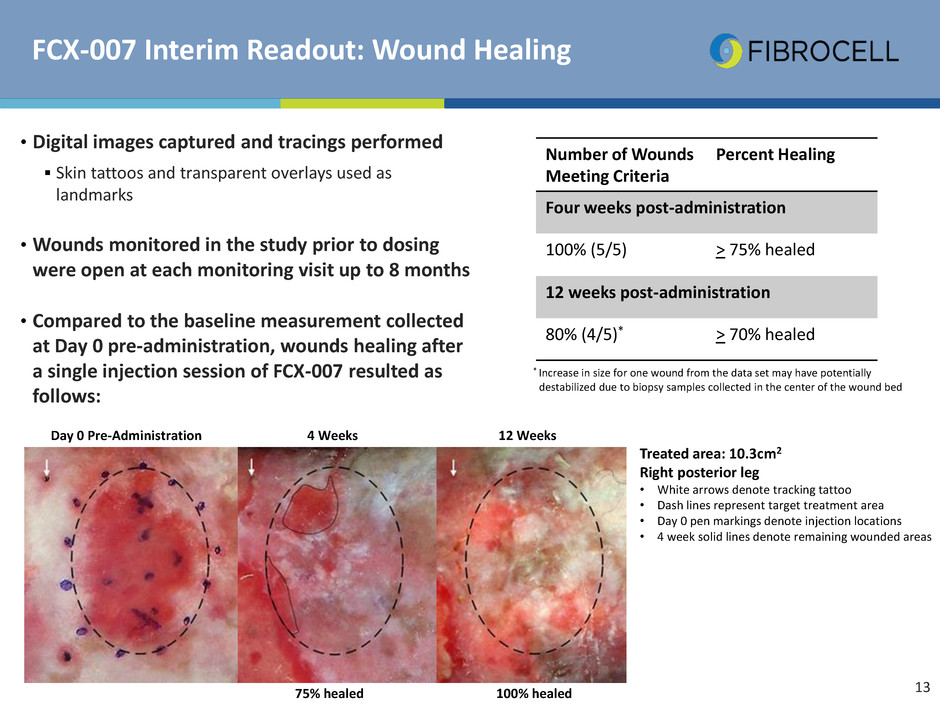
FCX-007 Interim Readout: Wound Healing
• Digital images captured and tracings performed
Skin tattoos and transparent overlays used as
landmarks
•Wounds monitored in the study prior to dosing
were open at each monitoring visit up to 8 months
• Compared to the baseline measurement collected
at Day 0 pre-administration, wounds healing after
a single injection session of FCX-007 resulted as
follows:
13
Number of Wounds
Meeting Criteria
Percent Healing
Four weeks post-administration
100% (5/5) > 75% healed
12 weeks post-administration
80% (4/5)* > 70% healed
* Increase in size for one wound from the data set may have potentially
destabilized due to biopsy samples collected in the center of the wound bed
Day 0 Pre-Administration 4 Weeks 12 Weeks
75% healed 100% healed
Treated area: 10.3cm2
Right posterior leg
• White arrows denote tracking tattoo
• Dash lines represent target treatment area
• Day 0 pen markings denote injection locations
• 4 week solid lines denote remaining wounded areas

FCX-007 Interim Readout: Pharmacology
14Texas Red – C7/fNC1 + DAPI + FITC – laminin 332Texas Red – C7/fNC1
• Variable pharmacology signals detected throughout the data set in each patient for one or more assays
through 12 weeks post-administration (qPCR, electron microscopy, immunofluorescence)
Anchoring fibrils have not been detected to date, whereas COL7 mRNA and COL7 protein have been confirmed in multiple
patient samples, including one that detected linear expression of COL7
• Linear expression of COL7 in the basement membrane zone (BMZ) and expression in the dermis detected
through 12 weeks post-administration
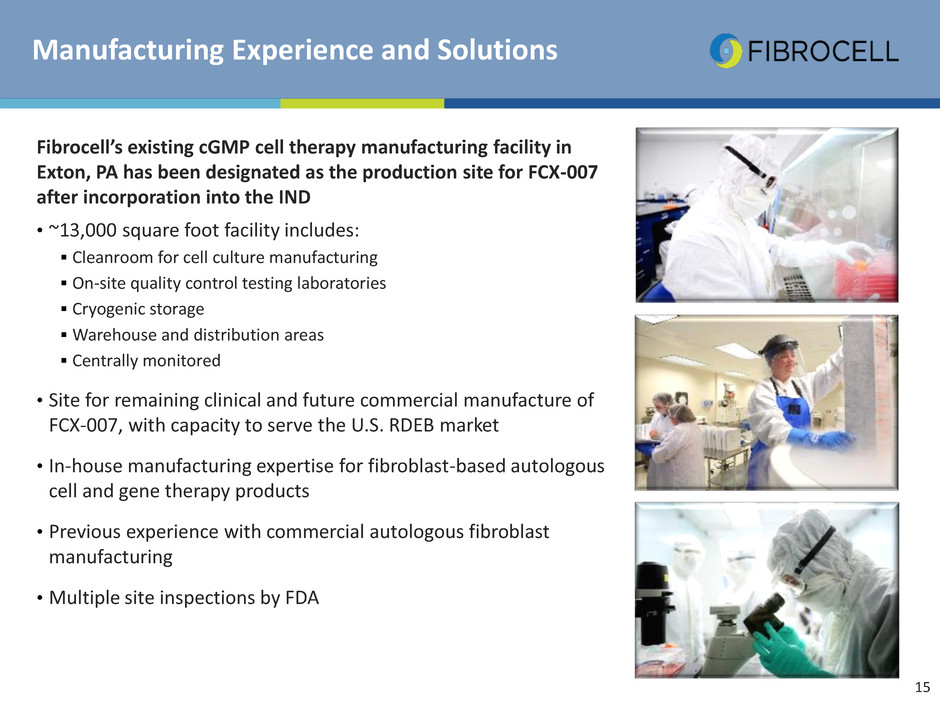
Fibrocell’s existing cGMP cell therapy manufacturing facility in
Exton, PA has been designated as the production site for FCX-007
after incorporation into the IND
• ~13,000 square foot facility includes:
Cleanroom for cell culture manufacturing
On-site quality control testing laboratories
Cryogenic storage
Warehouse and distribution areas
Centrally monitored
• Site for remaining clinical and future commercial manufacture of
FCX-007, with capacity to serve the U.S. RDEB market
• In-house manufacturing expertise for fibroblast-based autologous
cell and gene therapy products
• Previous experience with commercial autologous fibroblast
manufacturing
• Multiple site inspections by FDA
Manufacturing Experience and Solutions
15

Localized Scleroderma
16
Disease Epidemiology
• Excess production of collagen
characterized by skin fibrosis
and scars
• Focus on moderate to severe
subtypes, including linear
• Thickening may extend to
underlying tissue and muscle
in children which may impair
growth in affected limbs or
forehead
• Lesions appearing across
joints impair motion and may
be permanent
• Localized Scleroderma
~160,000 sufferers US5
comprised of different sub-
types
~90,000 patients are
considered moderate to
severe6
Current Treatments
Current treatments only
address symptoms:
• Systemic or topical
corticosteroids
• UVA light therapy
• Physical therapy
Photo: Reprinted from the Journal of the American Academy of Dermatology, Volume 59, Issue 3, Stéphanie Christen-Zaech, Miriam D. Hakim, F. Sule Afsar, Amy S. Paller.
Pediatric morphea (localized scleroderma): Review of 136 patients, Figure 1, pp. 385-396. Copyright Sept 2008. Used with permission from Elsevier Ltd.
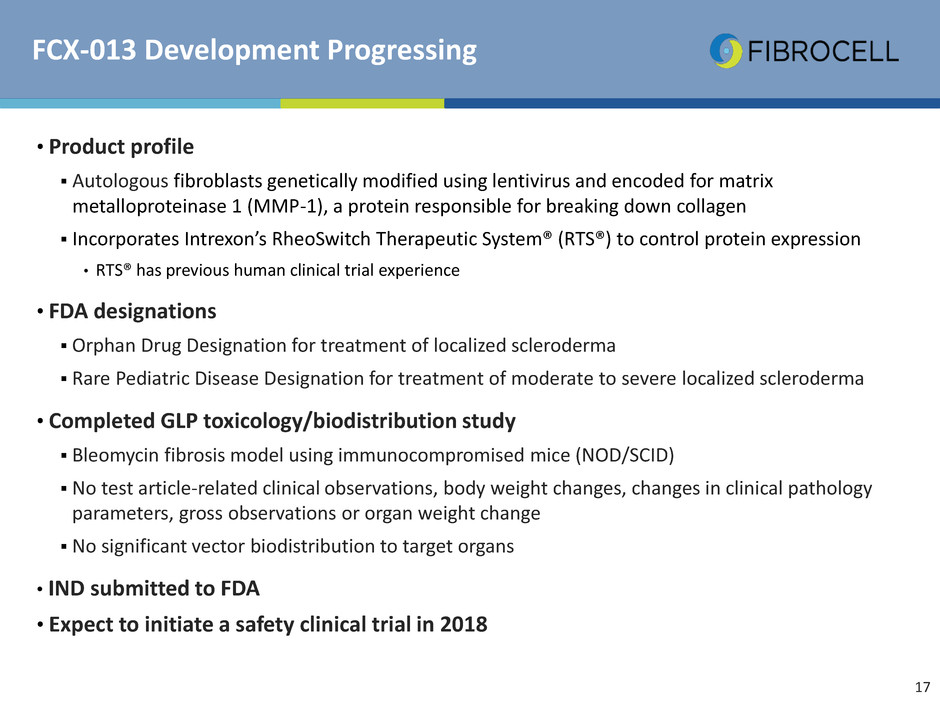
FCX-013 Development Progressing
17
• Product profile
Autologous fibroblasts genetically modified using lentivirus and encoded for matrix
metalloproteinase 1 (MMP-1), a protein responsible for breaking down collagen
Incorporates Intrexon’s RheoSwitch Therapeutic System® (RTS®) to control protein expression
• RTS® has previous human clinical trial experience
• FDA designations
Orphan Drug Designation for treatment of localized scleroderma
Rare Pediatric Disease Designation for treatment of moderate to severe localized scleroderma
• Completed GLP toxicology/biodistribution study
Bleomycin fibrosis model using immunocompromised mice (NOD/SCID)
No test article-related clinical observations, body weight changes, changes in clinical pathology
parameters, gross observations or organ weight change
No significant vector biodistribution to target organs
• IND submitted to FDA
• Expect to initiate a safety clinical trial in 2018

FCX-013 Proof-of-Concept Study
18
• Study Design
Bleomycin treated SCID mouse model
N=30 mice over test and control groups
Assessed histologically for reduction of dermal
thickness and sub-dermal muscle in the presence
of FCX-013 and oral ligand
• Result
Bleomycin treatment resulted in skin fibrosis, measured by a significant increase in dermal thickness
Demonstrated that FCX-013 with ligand reduced the dermal thickness of fibrotic tissue to levels
similar to non-bleomycin (saline) with ligand treated skin
Further reduced the thickness of the sub-dermal muscle layer
Blecomycin treatments Ligand Treatment
D0 D28 D29 D39
Cell
injection
Harvest skin
samples
CONTROL:
Saline (no Bleo)
No Cells
TEST:
Bleomycin
FCX-013
CONTROL:
Bleomycin
Non-Modified Cells

Research Program for Arthritis
19
• Deliver therapeutic protein locally to the joint providing sustained efficacy
while avoiding key side effects typically associated with systemic therapy
• Combines Fibrocell’s autologous fibroblast technology with Intrexon’s
cellular engineering to develop localized gene therapies
• Focused on addressing chronic inflammation and degenerative diseases
of the joint, including arthritis

Program Milestone Timing
FCX-007 FDA grants Fast Track Designation January 2017
FCX-007 Phase 1/2 trial first adult patient dosed February 2017
FCX-013 FDA grants Rare Pediatric Disease Designation June 2017
FCX-007 Phase 1/2 trial interim update September 2017
FCX-007 Enrolled first adult patient in Phase 2 3Q2017
FCX-007 Additional dosing of adult patients in Phase 1 4Q2017
FCX-007 Obtained FDA allowance to initiate pediatric enrollment in Phase 2 January 2018
FCX-013 IND submission January 2018
FCX-007 Dosing of first adult patient in Phase 2 2Q2018
FCX-013 Initiation of safety clinical trial 2018
Milestones and Financials
20
Category Amount
Cash at September 30, 2017 $11.9M; closed $10.5M raise (gross) December 2017
Share Count (Outstanding/Fully Diluted) 25.9M/62.5M as of December 28, 2017
Cash Runway Cash into 1Q2019
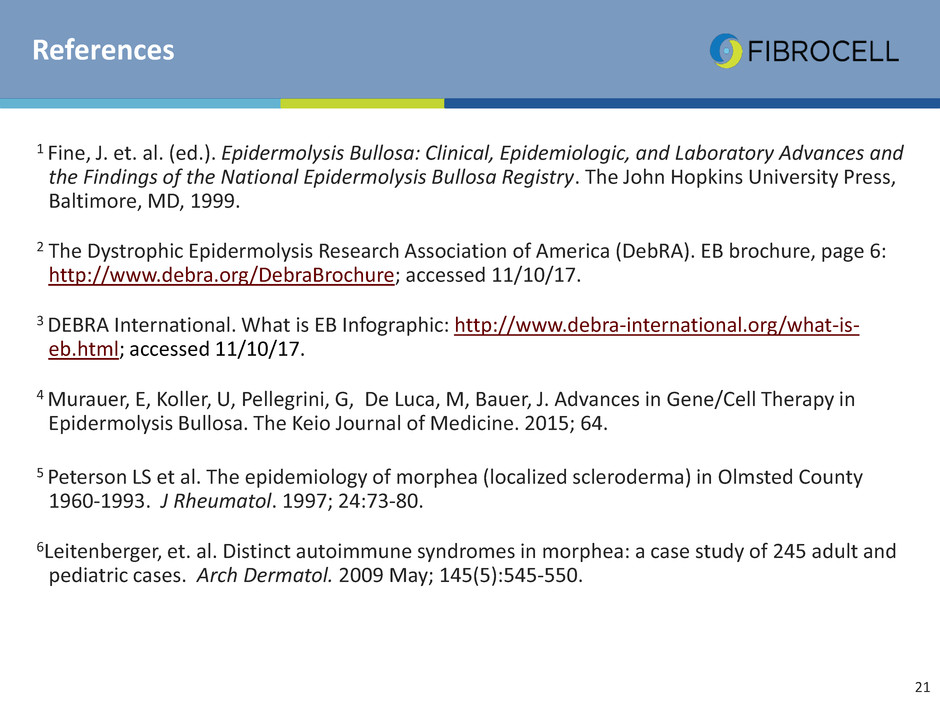
References
1 Fine, J. et. al. (ed.). Epidermolysis Bullosa: Clinical, Epidemiologic, and Laboratory Advances and
the Findings of the National Epidermolysis Bullosa Registry. The John Hopkins University Press,
Baltimore, MD, 1999.
2 The Dystrophic Epidermolysis Research Association of America (DebRA). EB brochure, page 6:
http://www.debra.org/DebraBrochure; accessed 11/10/17.
3 DEBRA International. What is EB Infographic: http://www.debra-international.org/what-is-
eb.html; accessed 11/10/17.
4 Murauer, E, Koller, U, Pellegrini, G, De Luca, M, Bauer, J. Advances in Gene/Cell Therapy in
Epidermolysis Bullosa. The Keio Journal of Medicine. 2015; 64.
5 Peterson LS et al. The epidemiology of morphea (localized scleroderma) in Olmsted County
1960-1993. J Rheumatol. 1997; 24:73-80.
6Leitenberger, et. al. Distinct autoimmune syndromes in morphea: a case study of 245 adult and
pediatric cases. Arch Dermatol. 2009 May; 145(5):545-550.
21
